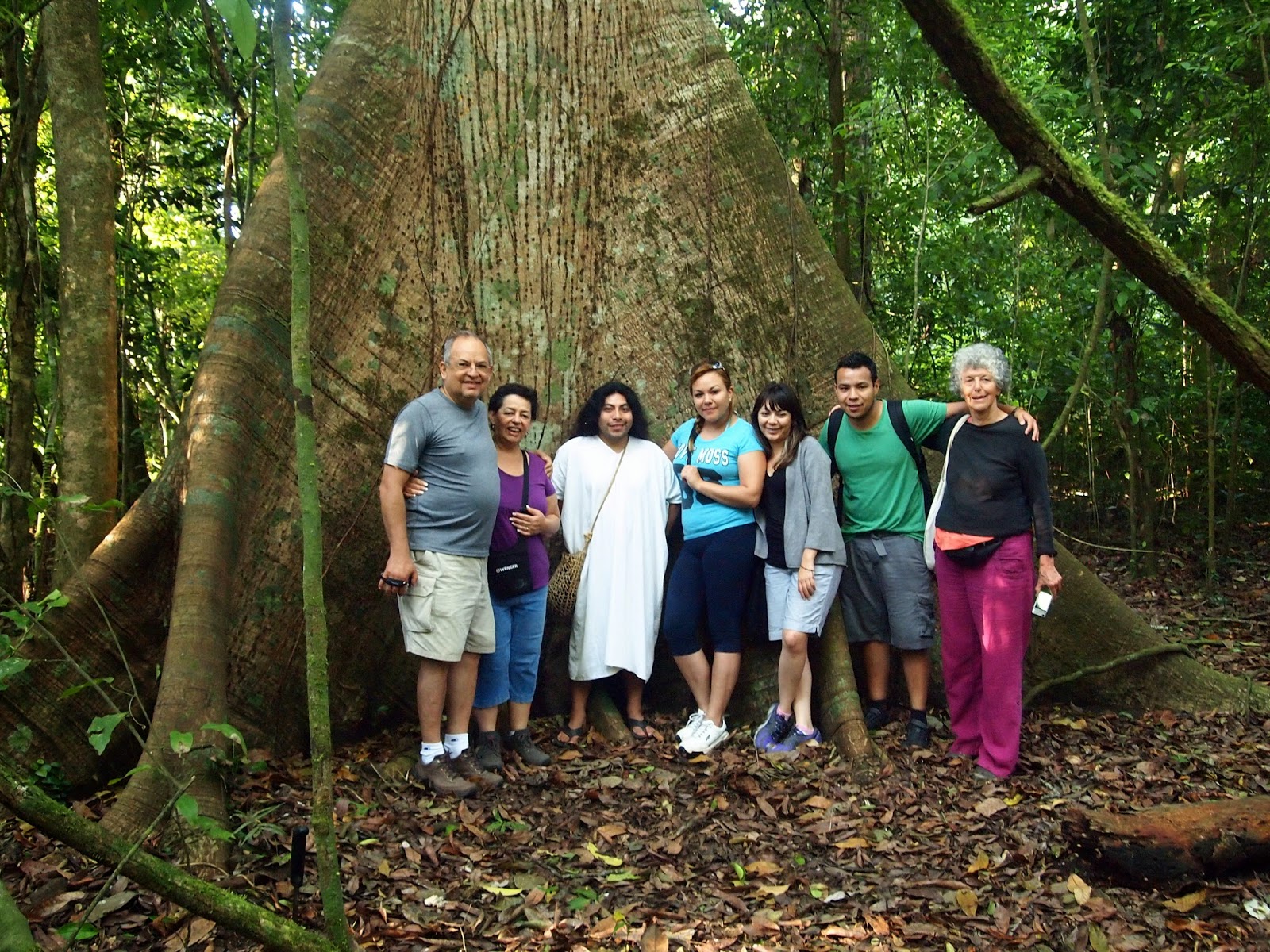At Victor's house, there was some native wildlife on display.
 |
| A semi-tame guacamaya |
 |
| A spider monkey rescued a year ago, its arm had been broken by a falling tree during the wet season |
 |
| Into the selva |
 |
| Some of our group |
 |
| Following Victor back out of the selva |
After our walk in the woods, we returned to Campamento Lacandones for breakfast and a three-hour drive to the town of Palenque and the major Maya archaeological site of the same name.
Along with Tikal in Guatemala and Copan in Honduras, Palenque was one the the three dominant Maya city-states during the late classical period of 600 to 900 A.D. Palenque has also played a significant role in modern Maya archaeology. It was here in 1952 that Alberto Ruz discovered the royal tomb of the great ruler, Pakal, buried deep within the Temple of the Inscriptions. It was also here in the 1970's that the top mayanists met annually and finally broke the code to reading the Maya hieroglyphics.
Palenque has always been, in my mind, the jewel of the Maya cities. It is large, has beautifully preserved buildings and is set right where the coastal plain meets the foothills, with the jungle rising up as a green backdrop.
I had been to Palenque twice before, first in 1968 as the leader of a group of high school kids on a summer exchange program, and again in 1978 with Sara. I looked forward to returning to Palenque a third time with much anticipation, but also with some misgivings.
Because Palenque is the most accessible of all the classic Maya sites, and because it is such a gem, tourism has grown substantially over the years. It is not a lost city in the jungle like Tikal or Yaxchilan. The town of Palenque, which barely existed when we were last there, is now filled with hotels, resorts and restaurants. A new airport has just been opened. I was afraid that the development and the crowds might have turned what was magical into Disneyland.
Outside what is now the Palenque National Park, some of what I feared has occurred. But great credit must be given the Mexican government. The archaeological site itself is still a gem. The wildness in gone; it is more like a manicured garden; but, it is still beautiful; and despite the number of people there, the size of the site makes it still feel uncrowded. All in all, it was a wonderful return visit.
Palenque has always been, in my mind, the jewel of the Maya cities. It is large, has beautifully preserved buildings and is set right where the coastal plain meets the foothills, with the jungle rising up as a green backdrop.
I had been to Palenque twice before, first in 1968 as the leader of a group of high school kids on a summer exchange program, and again in 1978 with Sara. I looked forward to returning to Palenque a third time with much anticipation, but also with some misgivings.
Because Palenque is the most accessible of all the classic Maya sites, and because it is such a gem, tourism has grown substantially over the years. It is not a lost city in the jungle like Tikal or Yaxchilan. The town of Palenque, which barely existed when we were last there, is now filled with hotels, resorts and restaurants. A new airport has just been opened. I was afraid that the development and the crowds might have turned what was magical into Disneyland.
Outside what is now the Palenque National Park, some of what I feared has occurred. But great credit must be given the Mexican government. The archaeological site itself is still a gem. The wildness in gone; it is more like a manicured garden; but, it is still beautiful; and despite the number of people there, the size of the site makes it still feel uncrowded. All in all, it was a wonderful return visit.
The pyramid in the photo above supports the Temple of the Inscriptions. It is under this temple, at essentially ground level, that Pakal's tomb lies. A hidden, interior stairway leads down through the floor of the temple to the tomb. This is what Alberto Ruz discovered in 1952. When we were here before, we were able to go down that long, steep stairway; however, as a protection to the fragile environment, public entrance has been discontinued. This is understandable, but sad. We feel fortunate to have had the privilege of visiting that tomb. Me twice.
 |
| The Mexican government gave permission for Alberto Ruz' ashes to be interred on the grounds at Palenque in recognition of his archaeological work there, a unique honor. |
On our five-hour drive home, we stopped for late lunch at Misol-Ha, another waterfall. The lunch of grilled fish was good, and the waterfall was very pretty. It was much more like the waterfalls in Oregon than the cascades we had seen earlier.
On our drive home we rose from close to sea level back to nearly seven thousand feet. We arrived back at our house in the dark, a little after nine o'clock, and went to bed. It is amazing how tiring just riding in a car can be.
The end of Day Three. A great field trip! A lot of time in a car!
On our drive home we rose from close to sea level back to nearly seven thousand feet. We arrived back at our house in the dark, a little after nine o'clock, and went to bed. It is amazing how tiring just riding in a car can be.
The end of Day Three. A great field trip! A lot of time in a car!


























Fantastic experience!
ReplyDelete